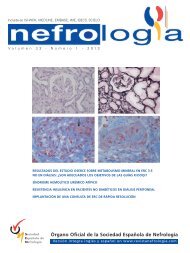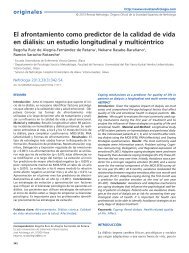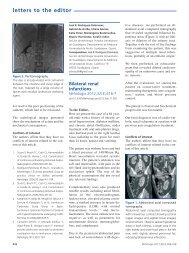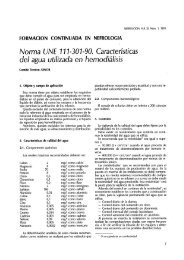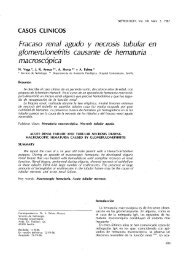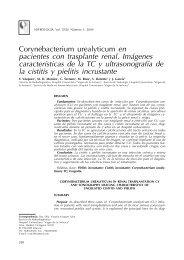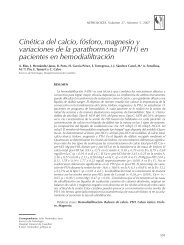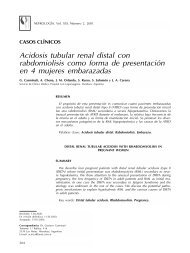originales - Nefrología
originales - Nefrología
originales - Nefrología
Create successful ePaper yourself
Turn your PDF publications into a flip-book with our unique Google optimized e-Paper software.
C. Botelho et al. Acute lupus hemophagocytic syndrome<br />
Figure 1. A bone marrow smear shows activated histiocyte<br />
phagocytosing hematopoietic cells (May-Giemsa stain, x400).<br />
Histological examination at light microscopy showed<br />
sclerosis in 6 of the 9 glomeruli, modest mesangial<br />
proliferation, tubular atrophy and diffuse interstitial fibrosis<br />
(figure 2).<br />
Immunofluorescence staining of 6 glomeruli revealed<br />
mesangial deposits of IgM and C3 (figure 3). The diagnosis<br />
of Focal Proliferative Lupus Nephritis (class III WHO) was<br />
established.<br />
No causative disorder for HS could be detected other than<br />
active SLE. The diagnosis of acute lupus hemophagocytic<br />
syndrome was established.<br />
The patient was treated with high-dose corticosteroid therapy<br />
with intravenous administration of methylprednisolone,<br />
1 g/day for 3 days followed by 1 mg/Kg/day p.o. Because of<br />
a partial response, five days after the initiation of the<br />
therapeutic scheme, 1 g of intravenous cyclophosphamide<br />
was added to her treatment.<br />
As the consequence of these treatments the patient improved<br />
clinically, the cytopenias reversed concomitantly with the<br />
suppression of hemophagocytic histiocytes, and the<br />
inflammatory indices, LFTs, and ferritin levels all gradually<br />
returned to normal. Two weeks later she was discharged in<br />
good condition on a tapered dose of oral steroids.<br />
DISCUSSION<br />
Hematologic involvement in SLE is a very common<br />
finding, but usually only one or 2 cell lines are affected.<br />
Pancytopenia occurs in fewer than 10% of patients and, in<br />
the absence of offending medication (ie, azathioprine,<br />
cyclophosphamide, and so on), is usually the result of<br />
peripheral destruction 6,11 .<br />
Nefrologia 2010;30(2):247-51<br />
casos clínicos<br />
Figure 2. PAS, x400: Glomerular sclerosis and mesangial<br />
proliferation.<br />
In our patient, all laboratory findings pointed to central<br />
marrow suppression. The extremely high ferritin, with<br />
normal CRP could not be explained by any other factor<br />
(ie, infection) than HS, because our patient also did not<br />
have evidence of malignancy or hemochromatosis. Liver<br />
dysfunction and excessively high ferritin fit well in HS and<br />
are caused by high levels of circulating cytokine (IL-1, IL-6,<br />
interferon-gamma [INF-gamma], TNF α) 12 .<br />
HS is a rare entity characterized by the proliferation of<br />
nonneoplastic cells of the histiocyte lineage that phagocytose<br />
the hematopoietic cells. It is usually aggressive, the outcome<br />
varies, and some cases are lethal 2,6 .<br />
HS can be associated with infection, malignancies,<br />
autoimmune diseases, drugs and immunosuppression. The<br />
infective agents include bacteria, viruses, most commonly<br />
Epstein-Barr virus and cytomegalovirus, or fungi.<br />
Figure 3. IF, x400: IgM and C3 mesangial deposits.<br />
249



